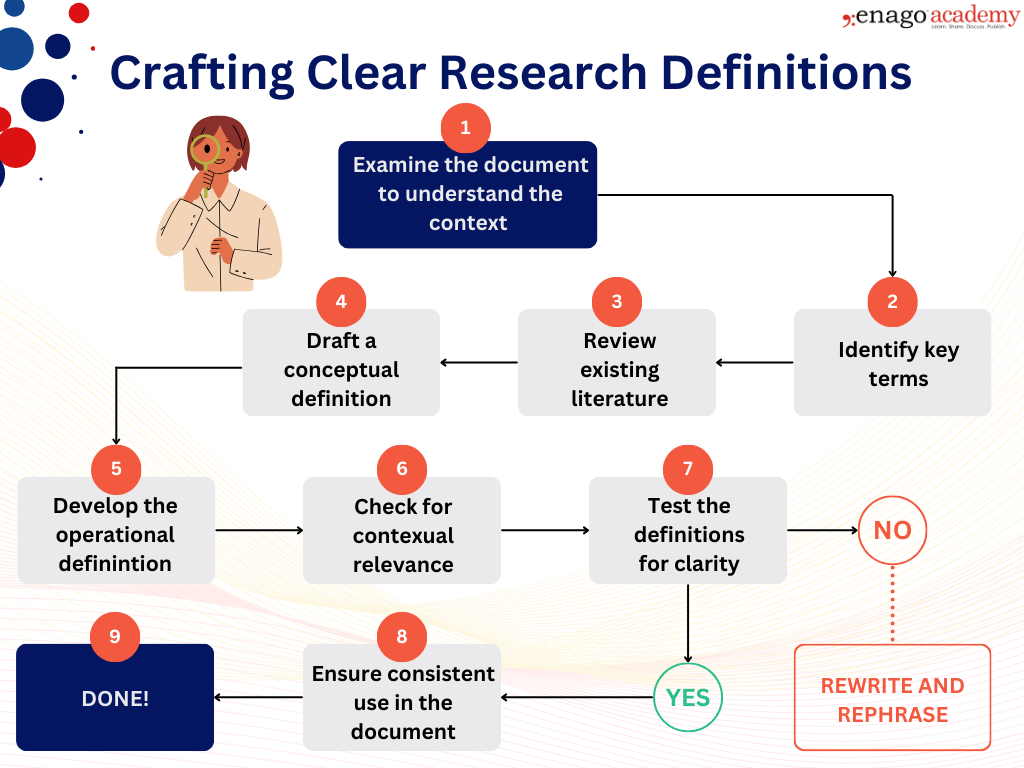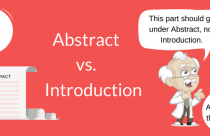The Role of Operational and Conceptual Definitions in Research

Writing ambiguous or inconsistent definitions in research lead to confusions and flawed conclusions. Clear explanations of technical terms, acronyms, and specialized terminologies are essential to ensure all readers share a common understanding of key concepts. This not only defines the scope and context of the study but also makes the research accessible to a broader audience, including students, and professionals; helping them engage with the research effectively and make informed decisions. Researchers can use several types of definitions depending on the context and nature of the study. Let’s have a closer look at the different types of definitions.
Types of Definitions
Researchers use different definitions, including lexical (standard dictionary meanings), operational (how terms are measured or observed), conceptual (provide theoretical understanding), and descriptive (outline key characteristics). Among these, operational and conceptual definitions play a particularly crucial role as they allow researchers to establish clear frameworks for data collection, analysis, and interpretation.
1. Conceptual Definitions
Conceptual definitions focus on the broader understanding of a concept. They describe the abstract nature of the concept and provide framework for understanding its general meaning within a specific field of study. They explain a concept’s essence. For example, defining “motivation” as the psychological force that drives individuals to achieve goals. Conceptual definitions establish a clear foundation to ensure consistency across different studies.
2. Operational Definitions
Operational definitions specify how a concept will be measured, observed, or applied in the study. These definitions turn abstract ideas into practical and testable elements that can be analyzed. They also clarify the procedures or instruments used to quantify a concept, ensuring that the study findings are reproducible and meaningful.
Examples of Conceptual and Operational Definitions
1. Motivation
-
- Conceptual Definition: Motivation is the internal process which guides and sustains goal-oriented behavior.
- Operational Definition: We measure motivation by the number of hours or effort spent on a task, such as the number of attempts in solving a puzzle.
2. Academic Achievement
-
- Conceptual Definition: Academic achievement refers to educational goals. It is often linked to understanding the subject matter and skills acquired.
- Operational Definition: The grade point average (GPA) and standardized test scores measure academic achievement.
3. Pain
-
- Conceptual Definition: Pain is a subjective experience of discomfort ranging from mild to severe and often indicates an injury or illness.
- Operational Definition: Patients report their pain intensity on a numerical rating scale (NRS), rating it from 0 (no pain) to 10 (worst pain imaginable) during a specific period.
4. Social Integration
-
- Conceptual Definition: Social integration is the extent to which individuals feel connected to a community.
- Operational Definition: We measure social integration by counting the number of social interactions per week and tracking participation in events or social organizations.
These examples illustrate the distinction between conceptual and operational definitions. The former provides a broad theoretical understanding, whereas the latter specifies how the research will measure or observe the concept. These distinctions lay the foundation for creating definitions. Let’s dive deeper into how to write operational and conceptual definitions!
Steps to Write Clear Definitions
Defining a term can be challenging since articulating ideas and concepts isn’t a daily practice. To successfully define any term a researcher must know exactly what and why they are studying, the context and scope of the term, and how they measure it. The infographic below illustrates a simple flow chart that can help craft clear definitions.

After writing your definitions you must always ensure that it aligns with the context of the study and their consistent reference to the same concept throughout the document. It is also advisable to test the definitions you have written for clarity amongst your peers. This litmus test can improve the quality of the definitions manifold!
Grab our Exclusive Checklist to help you craft clear and comprehensive definitions!
By following the checklist, you can create strong definitions, but it’s equally important to be aware of common mistakes that can undermine their quality. Let’s discuss some pitfalls to avoid when writing good definitions.
Common Mistakes in Crafting Definitions
Let’s take a closer look at the mistakes researchers often make when defining concepts.
- Using vague terms like “usually” or “typically”, introduces ambiguity and makes it difficult to draw clear conclusions
- Over-complicating definitions can also hinder understanding, making concepts harder to apply or interpret
- Inconsistent use of definitions throughout a study can undermine reliability, thus disrupting the logical flow and interpretation
- Lastly, when the context in which a definition is applied is ignored causes misunderstandings. The meaning of a concept may vary depending on cultural, environmental, or disciplinary factors.
In conclusion, clear and precise definitions are essential for producing credible, reliable, and impactful research. When key terms are correctly chosen and well-defined, researchers establish a foundation for accurate interpretation to avoid ambiguity that could lead to misinterpretation. Furthermore, well-crafted definitions promote consistency and transparency, making replicating studies and building upon existing knowledge easier. Ultimately, clear definitions enhance the overall quality of research making it valuable to the academic community.










